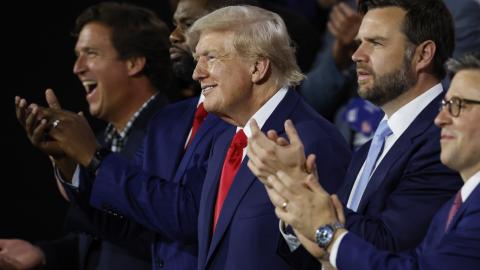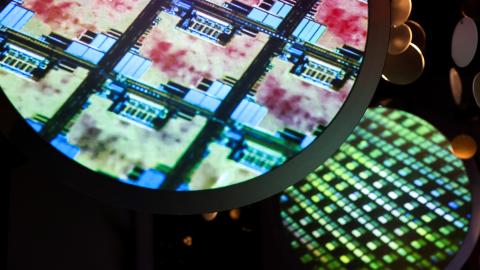Sunday, we Americans did what we always do on the Fourth. We grilled hot dogs and watched fireworks in celebration of the day in 1776 when we declared our independence of Britain by adopting "The Unanimous Declaration of The Thirteen United States of America." As Edmund Burke told the Parliament, "a succession of Acts of Tyranny" by the crown "was more than what ought to be endured." Then, as now, Americans were willing to wage war to unseat tyrants.
Americans have Iraq very much in mind, especially since we spent last week riveted to television images of a defiant Saddam Hussein telling a judge that Kuwait is part of Iraq. A further reminder of 9/11 came when ground was broken for the new 1,776-foot tower (a height chosen to commemorate the break with Britain in 1776) that will replace the Twin Towers.
Fortunately for the president, 54% of Americans tell pollsters that the transfer of authority to the Iraqis will improve the situation in Iraq, and only 39% say the transfer will make things worse. Although a majority of Americans doubt that the administration has a plan for the reconstruction of Iraq, 66% tell CBS/New York Times pollsters that America should keep troops in Iraq "as long as it takes that country to become a stable democracy." That is about all of the good news the president can wring from recent polls, which suggest to everyone except the White House staff that the campaign is going badly.
Preoccupation with Iraq is only one reason that the decision of the Federal Reserve Board's Monetary Policy Committee to raise interest rates by 0.25%, from its 45-year low of 1%, hardly proved earthshaking, even though it represents a reversal of a four-year trend of ever-lower rates. The muted reaction consisted of cheers from pensioners dependent on interest earned on savings accounts; yawns from the majority of Americans, who have financed their home purchases with fixed-rate mortgages, and from the markets, which had already priced in the long-anticipated increase; and concern from the inflation hawks who feel that Fed chairman Alan Greenspan is not moving hard and fast enough to nip inflation in its incipiency.
The hawks say that prices are rising at their fastest rate in four years, available excess capacity is disappearing, productivity growth is slowing, and unit labor costs are rising. Worse still, the items that consumers buy frequently -- apparel, food, medications, and petrol -- have been rising at double-digit rates in the past year (butter up 23%, steak 17%, drugs used by the elderly, over 7%), while only infrequently purchased and therefore less-noticed items such as used cars are becoming cheaper. That has fueled inflationary expectations.
The hawks also are fretting because they see no end to the loose fiscal policy that has a profligate government spending more than it takes in as far ahead as the eye can see. They think that the Fed needs to tighten to offset the Bush administrations inflation-producing deficits.
But Greenspan is faced with highly ambiguous economic data. Absent a spurt that takes the core inflation rate significantly above its current 1.7% rate, he will be satisfied with small increments that in the next 18 months will bring rates to something like 4%. Most economists believe that rate is compatible with economic growth that produces neither unemployment nor inflation. Had the Fed raised rates sooner and faster, as the inflation hawks think best, it would have ignored a great deal of economic evidence.
The recent increase in inflation may be due to transitory phenomena such as the commodity price rises that are already slowing, and in some cases reversing, as the Chinese economy cools. And the economy may be slowing. The jobs report, issued just a few days after Greenspan's gradualism ruffled the hawks' feathers, suggests that Greenspan has got it right. Non-farm employment increased by only 112,000, about half of what the inflation hawks were predicting, and average hourly wages rose a mere 0.1%. Good news for bonds, bad news for Bush.
Add to that the facts that the stimulus provided by the Bush tax cuts is fading, and that orders for durable goods in May fell for the second consecutive month. In June, U.S. vehicle sales slowed to an annual rate of around 12 million, well below analysts' forecasts of 13.7 million. Wal-Mart, which accounts for 8% of all non-vehicle sales in the U.S., last week lowered its forecast of sales growth. This might sound surprising, since the Conference Board reports that consumer confidence is at the highest level in two years. But another survey, by the University of Michigan, provides an explanation. Confidence among families with incomes of less than $50,000 -- Wal-Mart's customer base -- actually fell in May, while confidence among higher-income groups rose. The feel-good factor in the upper-income groups accounts for the double-digit growth that such pricey purveyors as Starbucks are reporting.
Greenspan also would have ignored the experience of 1994, when large and rapid increases caused serious problems for the financial sector. To avoid a repeat, he has been signaling hedge funds and others that rates will be going up, giving them ample warning to adjust their portfolios.
Greenspan knows that the risks of raising rates too much, too soon, and of doing too little, too late, are not symmetric. If he tromps on the brakes too hard, the financial system might be shaken, the housing industry might grind to a halt, and consumers and investors might retreat to the sidelines. In short, recession.
But if he errs in the other direction, and taps the brakes too lightly, the result will be a bit more inflation for a bit longer, a situation he can bring under control by raising rates more rapidly when the monetary gurus convene again on August 10. In a business in which there is a high probability of error, Greenspan knows which of the possible mistakes he would rather make.
A version of this Update appeared in The Sunday Times (London)



















